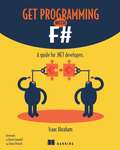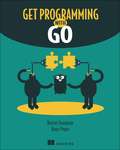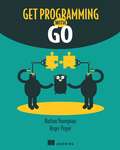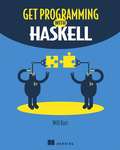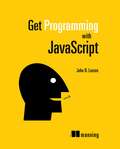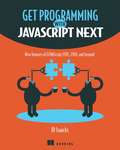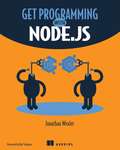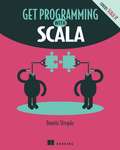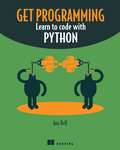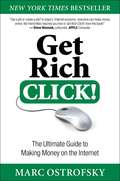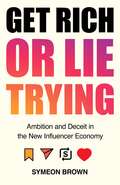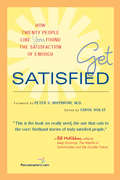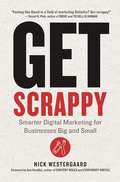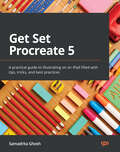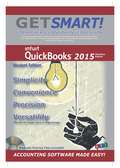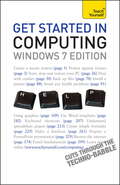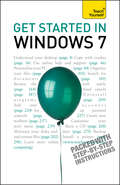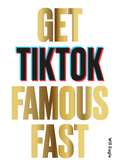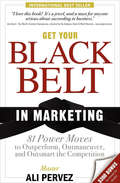- Table View
- List View
Get Out the Vote: How to Increase Voter Turnout
by Donald P. Green Alan S. GerberThe most important element in every election is getting voters to the polls-these get-out-the-vote (GOTV) efforts make the difference between winning and losing office. With the first two editions of Get Out the Vote, Donald P. Green and Alan S. Gerber broke ground by introducing a new scientific approach to the challenge of voter mobilization that profoundly influenced how campaigns operate. Get Out the Vote has become the reference text for those who manage campaigns and study voter mobilization.In this expanded and updated edition, Green and Gerber incorporate data from more than 100 new studies, which shed new light on the costeffectiveness and efficiency of various campaign tactics, including door-to-door canvassing, email, direct mail, and telephone calls. Two new chapters focus on the effectiveness of registration drives and messaging tactics. The new Get Out the Vote will be available as the country gears up for the 2016 presidential campaign. This readable, practical guide on voter mobilization is sure to be an important resource for consultants, candidates, and grassroots organizations, as well as a valuable teaching tool in courses on campaigns and elections.
Get Programming with F#: A guide for .NET developers
by Isaac AbrahamSummary Get Programming with F#: A guide for .NET developers teaches F# through 43 example-based lessons with built-in exercises so you can learn the only way that really works: by practicing. The book upgrades your .NET skills with a touch of functional programming in F#. You'll pick up core FP principles and learn techniques for iron-clad reliability and crystal clarity. You'll discover productivity techniques for coding F# in Visual Studio, functional design, and integrating functional and OO code. Purchase of the print book includes a free eBook in PDF, Kindle, and ePub formats from Manning Publications. About the Technology Your .NET applications need to be good for the long haul. F#'s unique blend of functional and imperative programming is perfect for writing code that performs flawlessly now and keeps running as your needs grow and change. It takes a little practice to master F#'s functional-first style, so you may as well get programming! What's Inside Learn how to write bug-free programs Turn tedious common tasks into quick and easy ones Use minimal code to work with JSON, CSV, XML, and HTML data Integrate F# with your existing C# and VB.NET applications Create web-enabled applications About the Reader Written for intermediate C# and Visual Basic .NET developers. No experience with F# is assumed. Table of Contents Unit 1 - F# AND VISUAL STUDIO Lesson 1 - The Visual Studio experience Lesson 2 - Creating your first F# program Lesson 3 - The REPL-changing how we develop Unit 2 - HELLO F# Lesson 4 - Saying a little, doing a lot Lesson 5 - Trusting the compiler Lesson 6 - Working with immutable data Lesson 7 - Expressions and statements Lesson 8 Capstone 1 Unit 3 - TYPES AND FUNCTIONS Lesson 9 - Shaping data with tuples Lesson 10 - Shaping data with records Lesson 11 - Building composable functions Lesson 12 - Organizing code without classes Lesson 13 - Achieving code reuse in F# Lesson 14 - Capstone 2 Unit 4 - COLLECTIONS IN F# Lesson 15 - Working with collections in F# Lesson 16 - Useful collection functions Lesson 17 - Maps, dictionaries, and sets Lesson 18 - Folding your way to success Lesson 19 - Capstone 3 Unit 5 - THE PIT OF SUCCESS WITH THE F# TYPE SYSTEM Lesson 20 - Program flow in F# Lesson 21 - Modeling relationships in F# Lesson 22 - Fixing the billion-dollar mistake Lesson 23 - Business rules as code Lesson 24 - Capstone 4 Unit 6 - LIVING ON THE .NET PLATFORM Lesson 25 - Consuming C# from F# Lesson 26 - Working with NuGet packages Lesson 27 - Exposing F# types and functionsto C# Lesson 28 - Architecting hybrid language applications Lesson 29 - Capstone 5 Unit 7 - WORKING WITH DATA Lesson 30 - Introducing type providers Lesson 31 - Building schemas from live data Lesson 32 - Working with SQL Lesson 33 - Creating type provider-backed APIs Lesson 34 - Using type providers in the real world Lesson 35 - Capstone 6 Unit 8 - WEB PROGRAMMING Lesson 36 - Asynchronous workflows Lesson 37 - Exposing data over HTTP Lesson 38 - Consuming HTTP data Lesson 39 - Capstone 7 Unit 9 - UNIT TESTING Lesson 40 - Unit testing in F# Lesson 41 - Property-based testing in F# Lesson 42 - Web testing Lesson 43 - Capstone 8 Unit 10 - WHERE NEXT? Appendix A - The F# community Appendix B - F# in my organization Appendix C - Must-visit F# resources Appendix D - Must-have F# libraries Appendix E - Other F# language feature
Get Programming with Go
by Nathan Youngman Roger PeppeHobbyists, newcomers, and professionals alike can benefit from a fast, modern language; all you need is the right resource! Get Programming with Go provides a hands-on introduction to Go language fundamentals, serving as a solid foundation for your future programming projects. You'll master Go syntax, work with types and functions, and explore bigger ideas like state and concurrency, with plenty of exercises to lock in what you learn.
Get Programming with Go
by Nathan Youngman Roger PeppeSummaryGet Programming with Go introduces you to the powerful Go language without confusing jargon or high-level theory. By working through 32 quick-fire lessons, you'll quickly pick up the basics of the innovative Go programming language! Purchase of the print book includes a free eBook in PDF, Kindle, and ePub formats from Manning Publications.About the TechnologyGo is a small programming language designed by Google to tackle big problems. Large projects mean large teams with people of varying levels of experience. Go offers a small, yet capable, language that can be understood and used by anyone, no matter their experience.About the BookHobbyists, newcomers, and professionals alike can benefit from a fast, modern language; all you need is the right resource! Get Programming with Go provides a hands-on introduction to Go language fundamentals, serving as a solid foundation for your future programming projects. You'll master Go syntax, work with types and functions, and explore bigger ideas like state and concurrency, with plenty of exercises to lock in what you learn.What's insideLanguage concepts like slices, interfaces, pointers, and concurrencySeven capstone projects featuring spacefaring gophers, Mars rovers, ciphers, and simulationsAll examples run in the Go Playground - no installation required!About the ReaderThis book is for anyone familiar with computer programming, as well as anyone with the desire to learn.About the AuthorNathan Youngman organizes the Edmonton Go meetup and is a mentor with Canada Learning Code. Roger Peppé contributes to Go and runs the Newcastle upon Tyne Go meetup.Table of ContentsUnit 0 - GETTING STARTEDGet ready, get set, Go Unit 1 - IMPERATIVE PROGRAMMINGA glorified calculator Loops and branches Variable scope Capstone: Ticket to MarsUnit 2 - TYPESReal numbers Whole numbers Big numbers Multilingual text Converting between types Capstone: The Vigenère cipher Unit 3 - BUILDING BLOCKSFunctions Methods First-class functions Capstone: Temperature tables Unit 4 - COLLECTIONSArrayed in splendor Slices: Windows into arrays A bigger slice The ever-versatile map Capstone: A slice of life Unit 5 - STATE AND BEHAVIORA little structure Go's got no class Composition and forwarding Interfaces Capstone: Martian animal sanctuary Unit 6 - DOWN THE GOPHER HOLEA few pointers Much ado about nil To err is human Capstone: Sudoku rules Unit 7 - CONCURRENT PROGRAMMINGGoroutines and concurrency Concurrent state Capstone: Life on Mars
Get Programming with Haskell
by Will KurtSummary Get Programming with Haskell leads you through short lessons, examples, and exercises designed to make Haskell your own. It has crystal-clear illustrations and guided practice. You will write and test dozens of interesting programs and dive into custom Haskell modules. You will gain a new perspective on programming plus the practical ability to use Haskell in the everyday world. (The 80 IQ points: not guaranteed.) Purchase of the print book includes a free eBook in PDF, Kindle, and ePub formats from Manning Publications. About the Technology Programming languages often differ only around the edges—a few keywords, libraries, or platform choices. Haskell gives you an entirely new point of view. To the software pioneer Alan Kay, a change in perspective can be worth 80 IQ points and Haskellers agree on the dramatic benefits of thinking the Haskell way—thinking functionally, with type safety, mathematical certainty, and more. In this hands-on book, that's exactly what you'll learn to do. What's Inside Thinking in Haskell Functional programming basics Programming in types Real-world applications for Haskell About the Reader Written for readers who know one or more programming languages. Table of Contents Lesson 1 Getting started with Haskell Unit 1 - FOUNDATIONS OF FUNCTIONAL PROGRAMMING Lesson 2 Functions and functional programming Lesson 3 Lambda functions and lexical scope Lesson 4 First-class functions Lesson 5 Closures and partial application Lesson 6 Lists Lesson 7 Rules for recursion and pattern matching Lesson 8 Writing recursive functions Lesson 9 Higher-order functions Lesson 10 Capstone: Functional object-oriented programming with robots! Unit 2 - INTRODUCING TYPES Lesson 11 Type basics Lesson 12 Creating your own types Lesson 13 Type classes Lesson 14 Using type classes Lesson 15 Capstone: Secret messages! Unit 3 - PROGRAMMING IN TYPES Lesson 16 Creating types with "and" and "or" Lesson 17 Design by composition—Semigroups and Monoids Lesson 18 Parameterized types Lesson 19 The Maybe type: dealing with missing values Lesson 20 Capstone: Time series Unit 4 - IO IN HASKELL Lesson 21 Hello World!—introducing IO types Lesson 22 Interacting with the command line and lazy I/O Lesson 23 Working with text and Unicode Lesson 24 Working with files Lesson 25 Working with binary data Lesson 26 Capstone: Processing binary files and book data Unit 5 - WORKING WITH TYPE IN A CONTEXT Lesson 27 The Functor type class Lesson 28 A peek at the Applicative type class: using functions in a context Lesson 29 Lists as context: a deeper look at the Applicative type class Lesson 30 Introducing the Monad type class Lesson 31 Making Monads easier with donotation Lesson 32 The list monad and list comprehensions Lesson 33 Capstone: SQL-like queries in Haskell Unit 6 - ORGANIZING CODE AND BUILDING PROJECTS Lesson 34 Organizing Haskell code with modules Lesson 35 Building projects with stack Lesson 36 Property testing with QuickCheck Lesson 37 Capstone: Building a prime-number library Unit 7 - PRACTICAL HASKELL Lesson 38 Errors in Haskell and the Either type Lesson 39 Making HTTP requests in Haskell Lesson 40 Working with JSON data by using Aeson Lesson 41 Using databases in Haskell Lesson 42 Efficient, stateful arrays in Haskell Afterword - What's next? Appendix - Sample answers to exercise
Get Programming with JavaScript
by John LarsenSummaryGet Programming with JavaScript is a hands-on introduction to programming for readers who have never programmed. You'll be writing your own web apps, games, and programs in no time! Foreword by Remy Sharp.Purchase of the print book includes a free eBook in PDF, Kindle, and ePub formats from Manning Publications.About the BookAre you ready to start writing your own web apps, games, and programs? You’re in the right place! Get Programming with JavaScript is a hands-on introduction to programming for readers who have never written a line of code. Since you’re just getting started, this friendly book offers you lots of examples backed by careful explanations. As you go along, you’ll find exercises to check your understanding and plenty of opportunities to practice your new skills. You don’t need anything special to follow the examples—just the text editor and web browser already installed on your computer. We even give you links to working online code so you can see how everything should look live on your screen.What’s InsideAll the basics—objects, functions, responding to users, and moreThink like a coder and design your own programsCreate a text-based adventure gameEnhance web pages with JavaScriptRun your programs in a web browserFour bonus chapters available onlineAbout the ReaderNo experience required! All you need is a web browser and an internet connection.About the AuthorJohn Larsen is a mathematics and computing teacher with an interest in educational research. He has an MA in mathematics and an MSc in information technology. He started programming in 1982, writing simple programs for teaching mathematics in 1993, building websites in 2001, and developing data-driven web-based applications for education in 2006.Table of ContentsPART 1 CORE CONCEPTS ON THE CONSOLEProgramming, JavaScript, and JS BinVariables: storing data in your programObjects: grouping your dataFunctions: code on demandArguments: passing data to functionsReturn values: getting data from functionsObject arguments: functions working with objectsArrays: putting data into listsConstructors: building objects with functionsBracket notation: flexible property namesPART 2 ORGANIZING YOUR PROGRAMSScope: hiding informationConditions: choosing code to runModules: breaking a program into piecesModels: working with dataViews: displaying dataControllers: linking models and viewsPART 3 JAVASCRIPT IN THE BROWSERHTML: building web pagesControls: getting user inputTemplates: filling placeholders with dataXHR: loading dataConclusion: get programming with JavaScriptBONUS ONLINE CHAPTERSNode: running JavaScript outside the browserExpress: building an APIPolling: repeating requests with XHRSocket.IO: real-time messaging
Get Programming with JavaScript Next: New features of ECMAScript 2015, 2016, and beyond
by JD IsaacksSummaryGet Programming with JavaScript Next introduces the modern age of JavaScript programming with ES6 and ES7 without dragging you through confusing jargon and abstract examples you'll never use. In just 34 quick-fire sessions, you'll quickly be coding with the latest features and functions of ES6 and ES7! Purchase of the print book includes a free eBook in PDF, Kindle, and ePub formats from Manning Publications.About the TechnologyGreat code is readable, bug-free, and maintainable. Modern JavaScript, aka JavaScript Next, makes it much, much easier to write great applications. New features introduced in ES2015 simplify the structure of your JavaScript projects and radically streamline async-oriented tasks like writing reactive applications and microservices. About the BookGet Programming with JavaScript Next introduces you to the new features included in the ES2015-and-later JavaScript releases. You'll learn example by example in 34 short lessons, each designed to drive home a specific skill. The coverage is complete: you'll explore new language syntax, declarations, and data types. You'll structure code with modules, replace callbacks with promises, and use classes instead of constructors. Every time you turn a page, complete an exercise, or study a carefully crafted illustration, you'll be one step closer to JavaScript mastery. What's InsideNew features from ES2015 and laterWriting asynchronous codeCreating custom iterablesTroubleshooting modules and classes About the ReaderWritten for web developers comfortable with standard JavaScript 5 features and coding style.About the AuthorJ.D. Isaacks is a seasoned developer, a JavaScript instructor, and an open source maintainer.Table of ContentsLesson 1 - ECMAScript specification and the proposal process Lesson 2 - Transpiling with Babel Lesson 3 - Bundling modules with Browserify UNIT 1 - VARIABLES AND STRINGSLesson 4 - Declaring variables with let Lesson 5 - Declaring constants with const Lesson 6 - New string methods Lesson 7 - Template literals Lesson 8 - Capstone: Building a domain-specific language UNIT 2 - OBJECTS AND ARRAYSLesson 9 - New array methods Lesson 10 - Object.assign Lesson 11 - Destructuring Lesson 12 - New object literal syntax Lesson 13 - Symbol-a new primitive Lesson 14 - Capstone: Simulating a lock and key UNIT 3 - FUNCTIONSLesson 15 - Default parameters and rest Lesson 16 - Destructuring parameters Lesson 17 - Arrow functions Lesson 18 - Generator functions Lesson 19 - Capstone: The prisoner's dilemma UNIT 4 - MODULESLesson 20 - Creating modules Lesson 21 - Using modules Lesson 22 - Capstone: Hangman game UNIT 5 - ITERABLESLesson 23 - Iterables Lesson 24 - Sets Lesson 25 - Maps Lesson 26 - Capstone: Blackjack UNIT 6 - CLASSESLesson 27 - Classes Lesson 28 - Extending classes Lesson 29 - Capstone: Comets UNIT 7 - WORKING ASYNCHRONOUSLYLesson 30 - Promises Lesson 31 - Advanced promises Lesson 32 - Async functions Lesson 33 - Observables Lesson 34 - Capstone: Canvas image gallery Appendix - Exercise answers
Get Programming with Node.js
by Jonathan WexlerSummary Get Programming with Node.js teaches you to build web servers using JavaScript and Node. In this engaging tutorial, you'll work through eight complete projects, from writing the code for your first web server to adding live chat to a web app. Your hands will stay on the keyboard as you explore the most important aspects of the Node development process, including security, database management, authenticating user accounts, and deploying to production. You'll especially appreciate the easy-to-follow discussions, illuminating diagrams, and carefully explained code! Purchase of the print book includes a free eBook in PDF, Kindle, and ePub formats from Manning Publications. About the Technology Node.js delivers the speed and reliability you need for ecommerce, social media, and gaming applications. It comes with thousands of prebuilt packages to help you get started immediately. If you want to use JavaScript on the server, Node.js is your choice. What's inside New features from ES2015 and later Writing asynchronous code Creating data models Debugging JavaScript modules About the Reader Written for front-end web developers with intermediate JavaScript skills. Table of Contents GETTING SET UP Lesson 0 - Setting up Node.js and the JavaScript engine Lesson 1 - Configuring your environment Lesson 2 - Running a Node.js application UNIT 1 - GETTING STARTED WITH NODE.JS Lesson 3 - Creating a Node.js module Lesson 4 - Building a simple web server in Node.js Lesson 5 - Handling incoming data Lesson 6 - Writing better routes and serving external files Lesson 7 - Capstone: Creating your first web application UNIT 2 - EASIER WEB DEVELOPMENT WITH EXPRESS.JS Lesson 8 - Setting up an app with Express.js Lesson 9 - Routing in Express.js Lesson 10 - Connecting views with templates Lesson 11 - Configurations and error handling Lesson 12 - Capstone: Enhancing the Confetti Cuisine site with Express.js UNIT 3 - CONNECTING TO A DATABASE Lesson 13 - Setting up a MongoDB database Lssson 14 - Building models with Mongoose Lesson 15 - Connecting controllers and models Using promises with Mongoose Lesson 16 - Capstone: Saving user subscriptions UNIT 4 - BUILDING A USER MODEL Lesson 17 - Improving your data models Lesson 18 - Building the user model Lesson 19 - Creating and reading your models Lesson 20 - Updating and deleting your models Lesson 21 - Capstone: Adding CRUD models to Confetti Cuisine Creating controllers UNIT 5 - AUTHENTICATING USER ACCOUNTS Lesson 22 - Adding sessions and flash messages Lesson 23 - Building a user login and hashing passwords Lesson 24 - Adding user authentication Lesson 25 - Capstone: Adding user authentication to Confetti Cuisine UNIT 6 - BUILDING AN API Lesson 26 - Adding an API to your application Lesson 27 - Accessing your API from your application Lesson 28 - Adding API security Lesson 29 - Capstone: Implementing an API UNIT 7 - ADDING CHAT FUNCTIONALITY Lesson 30 - Working with Socket.io Lesson 31 - Saving chat messages Lesson 32 - Adding a chat notification indicator UNIT 8 - DEPLOYING AND MANAGING CODE IN PRODUCTION Lesson 33 - Capstone: Adding a chat feature to Confetti Cuisine Lesson 34 - Deploying your application Lesson 35 - Managing in production Lesson 36 - Testing your application Lesson 37 - Capstone: Deploying Confetti Cuisine
Get Programming with Scala
by Daniela SfregolaThe perfect starting point for your journey into Scala and functional programming.Summary In Get Programming in Scala you will learn: Object-oriented principles in Scala Express program designs in functions Use types to enforce program requirements Use abstractions to avoid code duplication Write meaningful tests and recognize code smells Scala is a multi-style programming language for the JVM that supports both object-oriented and functional programming. Master Scala, and you'll be well-equipped to match your programming approach to the type of problem you're dealing with. Packed with examples and exercises, Get Programming with Scala is the perfect starting point for developers with some OO knowledge who want to learn Scala and pick up a few FP skills along the way. Purchase of the print book includes a free eBook in PDF, Kindle, and ePub formats from Manning Publications. About the technology Scala developers are in high demand. This flexible language blends object-oriented and functional programming styles so you can write flexible, easy-to-maintain code. Because Scala runs on the JVM, your programs can interact seamlessly with Java libraries and tools. If you&’re comfortable writing Java, this easy-to-read book will get you programming with Scala fast. About the book Get Programming with Scala is a fast-paced introduction to the Scala language, covering both Scala 2 and Scala 3. You&’ll learn through lessons, quizzes, and hands-on projects that bring your new skills to life. Clear explanations make Scala&’s features and abstractions easy to understand. As you go, you&’ll learn to write familiar object-oriented code in Scala and also discover the possibilities of functional programming. What's inside Apply object-oriented principles in Scala Learn the core concepts of functional programming Use types to enforce program requirements Use abstractions to avoid code duplication Write meaningful tests and recognize code smells About the reader For developers who know an OOP language like Java, Python, or C#. No experience with Scala or functional programming required. About the author Daniela Sfregola is a Senior Software Engineer and a Scala user since 2013. She is an active contributor to the Scala Community, a public speaker at Scala conferences and meetups, and a maintainer of open-source projects. Table of Contents Unit 0 HELLO SCALA! Unit 1 THE BASICS Unit 2 OBJECT-ORIENTED FUNDAMENTALS Unit 3 HTTP SERVER Unit 4 IMMUTABLE DATA AND STRUCTURES Unit 5 LIST Unit 6 OTHER COLLECTIONS AND ERROR HANDLING Unit 7 CONCURRENCY Unit 8 JSON (DE)SERIALIZATION
Get Programming: Learn to code with Python
by Ana BellGet Programming: Learn to code with Python teaches you the basics of computer programming using the Python language. In this exercise-driven book, you'll be doing something on nearly every page as you work through 38 compact lessons and 7 engaging capstone projects. By exploring the crystal-clear illustrations, exercises that check your understanding as you go, and tips for what to try next, you'll start thinking like a programmer in no time. This book works perfectly alongside our video course Get Programming with Python in Motion, available exclusively at Manning.com: www.manning.com/livevideo/get-programming-with-python-in-motion Purchase of the print book includes a free eBook in PDF, Kindle, and ePub formats from Manning Publications. What's Inside Programming skills you can use in any language Learn to code—no experience required Learn Python, the language for beginners Dozens of exercises and examples help you learn by doing About the Reader No prior programming experience needed. Table of Contents LEARNING HOW TO PROGRAM Lesson 1 - Why should you learn how to program? Lesson 2 - Basic principles of learning a programming language UNIT 1 - VARIABLES, TYPES, EXPRESSIONS, AND STATEMENTS Lesson 3 - Introducing Python: a programming language Lesson 4 - Variables and expressions: giving names and values to things Lesson 5 - Object types and statements of code 46 Lesson 6 - Capstone project: your first Python program-convert hours to minutes UNIT 2 - STRINGS, TUPLES, AND INTERACTING WITH THE USER Lesson 7 - Introducing string objects: sequences of characters Lesson 8 - Advanced string operations Lesson 9 - Simple error messages Lesson 10 - Tuple objects: sequences of any kind of object Lesson 11 - Interacting with the user Lesson 12 - Capstone project: name mashup UNIT 3 - MAKING DECISIONS IN YOUR PROGRAMS Lesson 13 - Introducing decisions in programs Lesson 14 - Making more-complicated decisions Lesson 15 - Capstone project: choose your own adventure UNIT 4 - REPEATING TASKS Lesson 16 - Repeating tasks with loops Lesson 17 - Customizing loops Lesson 18 - Repeating tasks while conditions hold Lesson 19 - Capstone project: Scrabble, Art Edition UNIT 5 - ORGANIZING YOUR CODE INTO REUSABLE BLOCKS Lesson 20 - Building programs to last Lesson 21 - Achieving modularity and abstraction with functions Lesson 22 - Advanced operations with functions Lesson 23 - Capstone project: analyze your friends UNIT 6 - WORKING WITH MUTABLE DATA TYPES Lesson 24 - Mutable and immutable objects Lesson 25 - Working with lists Lesson 26 - Advanced operations with lists Lesson 27 - Dictionaries as maps between objects Lesson 28 - Aliasing and copying lists and dictionaries Lesson 29 - Capstone project: document similarity UNIT 7 - MAKING YOUR OWN OBJECT TYPES BY USING OBJECT-ORIENTED PROGRAMMING Lesson 30 - Making your own object types Lesson 31 - Creating a class for an object type Lesson 32 - Working with your own object types Lesson 33 - Customizing classes Lesson 34 - Capstone project: card game UNIT 8 - USING LIBRARIES TO ENHANCE YOUR PROGRAMS Lesson 35 - Useful libraries Lesson 36 - Testing and debugging your programs Lesson 37 - A library for graphical user interfaces Lesson 38 - Capstone project: game of tag Appendix A - Answers to lesson exercises Appendix B - Python cheat sheet Appendix C - Interesting Python libraries
Get Rich Click!
by Marc OstrofskyThe Internet is arguably the most powerful business tool in the history of mankind. You can use it to make money, save money, and create new revenue streams quickly and easily, often with no start-up capital. The Internet is changing the way business is conducted and fortunes are made! Get Rich Click! shows you how to jump in and begin making money online immediately. Author Marc Ostrofsky is an entrepreneur and Internet pioneer whose companies make $75 million annually. He outlines the strategies that made him a multimillionaire despite having no technical skills and never creating a single website. His key to success: "Know your strengths, outsource your weaknesses, and know what you don't know." Using real-life examples from people of all ages and walks of life who have made their fortunes online, this engaging guide gives you step-by-step instructions for achieving financial success. You'll learn hundreds of unique ways to make money online with Facebook, Twitter, and other social sites, domain names, Pay Per Click, digitally based products, ways to make money with no money--even how to get a check each month from Google! He teaches: The key to financial success in our Internet-based economy is "Learn More, Earn MoreTM." If you think you've missed the window of opportunity in the digital world, Marc Ostrofsky says otherwise. Everyone has the capacity to learn and profit in the new economy--no matter what their skills, knowledge, or experience. Now is the time to change your ideas about making money, accumulating wealth, and taking control of your financial future. Let Marc Ostrofsky show you the way in Get Rich Click!
Get Rich or Lie Trying: Ambition and Deceit in the New Influencer Economy
by Symeon Brown'Compelling.' Reni Eddo-LodgeA 'must-read book for 2022', as picked by StylistMore than one fifth of children want to become influencers and it's easy to understand why. What if you could escape economic uncertainty by winning the internet's attention? What if you could turn the adoration of your social media followers into a lucrative livelihood?But as Symeon Brown explores in this searing exposé, the reality is much murkier. From IRL streamers in LA to Brazilian butt lifts, from sex workers on OnlyFans to fraudulent cryptocurrency schemes, these are the incredible stories that lurk behind the filtered selfies and gleaming smiles.Exposing the fraud, exploitation, bribery, and dishonesty at the core of the influencer model, Get Rich or Lie Trying asks if our digital rat race is costing us too much. Revealing a broken economy resembling a pyramid scheme, this incredible blend of reportage and analysis will captivate and horrify you in equal measure.
Get Satisfied
by Peter C. Whybrow Carol HolstWhat do Americans need that most eludes them? It's not a tank of cheap gas (as astonishing as that would be) or ever earlier pre-holiday sales. What Americans need most - and most of them know it - is satisfaction, especially the satisfaction of enough.So when the call for submissions to this book went out, the mainstream response was enthusiastic. From the outpouring of personal stories submitted, the editorial committee chose these twenty to represent the broadest possible spectrum of Americans who have sought and found a simpler, more satisfying life.
Get Scrappy: Smarter Digital Marketing for Businesses Big and Small
by Nick WestergaardIt's an exciting time to be in marketing: The Internet, social media, and content marketing are powerful equalizers, resetting the playing field for businesses large and small. Yet, it's also a challenging time, with much work to do and an ever-changing array of platforms, features, and networks to master--all on a tighter budget than before. Don't get discouraged, get scrappy! Shattering the myth that only big brands can do big things, Get Scrappy will help you: Demystify digital marketing in a way that makes sense for your business Do more with less Build a strong brand with something to say Find inspiration in unexpected places Create relevant and engaging content and promote it via Twitter, Facebook, and other channels Integrate strategy and message across touchpoints for a unified brand experience--both online and off Spark dialogue with your community of customers Measure what matters The result is a reliable, repeatable system for reinventing your marketing as marketing reinvents itself. Featuring frameworks, hacks, tips, idea starters, and more, Get Scrappy is the map you need to take your marketing from good to great.
Get Set Procreate 5: A practical guide to illustrating on an iPad filled with tips, tricks, and best practices
by Samadrita GhoshDiscover hacks to quickly get started with Procreate with the help of this color guide and learn how to use it on an iPad to create exquisite illustrations and animationsKey FeaturesFollow step-by-step instructions and tips on how to use Procreate to get the most out of itWork through hands-on tutorials with real artwork that will boost your confidence to explore Procreate furtherHighly recommended for iPad users who want to be able to paint on the goBook DescriptionProcreate is robust, industry-grade painting software that is extremely versatile yet an affordable alternative to subscription-based applications. If you're new to Procreate, Get Set Procreate 5 will help you get up to speed with creating professional illustrations in no time. Complete with step-by-step instructions, detailed explanations, and practical application guidelines, this easy-to-follow guide will cover the ins and outs of Procreate 5.2 and show you how to use each feature effectively. You'll learn how to draw using assistive tools, apply effects, create animations, and develop amazing artwork by implementing the skills learned throughout the book. Once you've got to grips with the new features of Procreate 5 for creating beautiful illustrations, animations, and graphics, you'll be able to explore the tools at your disposal and even create your own brushes, shortcuts, and menus to work efficiently. By the end of this Procreate book, you'll be able to navigate the application confidently and take your artwork to a new level.What you will learnBecome well-versed with the fundamentals of ProcreatePersonalize the Procreate application to suit your workflowGain preliminary knowledge of the tool to further explore it for your artworkSpeed up your workflow with gestures and shortcutsExplore, edit, and create a wide range of brushes with the help of Brush Library and Brush StudioUse assisted drawing tools to enhance your accuracyLearn animation using Procreate's Animation Assist toolsGet up-to-date with the new features of Procreate 5.2 like Page Assist and 3D painting.Who this book is forIf you're a beginner who wants to start illustrating professionally on Procreate, but feel lost about where to start, this is the right book for you! Start learning right from the very basics, and build up your knowledge step-by-step. This book is also a perfect fit for experienced illustrators/animators accustomed to other software like Photoshop, who would like to pick up a new skill.
Get Social: Social Media Strategy and Tactics for Leaders
by Michelle CarvillBusiness leaders' audiences - their customers, competitors and employees alike - live and breathe social media. In our hyperconnected culture, social media is the glue that allows us to stay connected to communities, products and brands. If your customers are on social media, along with your competition, then shouldn't you be there too? Get Social untangles the social media folklore and gets to the point of how business leaders and aspiring leaders can personally use social media to get real business results. Leaders who use social media platforms right have been shown to be more connected to their customers and employees, they gather major market research advantage by being part of the social conversation and they embody their brand message thus connecting with people on an authentic level.Get Social guides you through what you need to know about social media, and how it connects to your wider business strategy and the bottom line. Michelle Carvill helps you to identify how you can find your voice through all the different platforms and consistently be the leader you want to be. Along with a social CEO health check, Get Social offers invaluable templates, content plans and profiles of successful social media savvy CEOs. This book will give you all the tools you need to successfully launch yourself in the social conversation and see immediate results for your career and business.
Get Started In Computing: Teach Yourself
by Moira StephenGet Started in Computing is perfect for any new computer user who wants to get up and running quickly and simply. If you are a beginner it is a cost-effective alternative to buying an expensive manual for each application. Though Written for the general user, you will also find the level and content relevant if you are following MOUS certification, SQA modules and BCS Level 1/2 application courses.With step-by-step instructions, minimal jargon and detailed explanations of all the technical terms, this book will give you the confidence to move forward and expand your knowledge. Updated for Windows 7, the book covers all the basics, helping you to find ways of using your computer to suit you. Also included:- Health and safety laws and guidelines affecting the use of IT- Creating and maintaining a safe workstation environment- MS Office interface - ribbon, tabs, groups, MSO button and menu, Quick Access toolbar- Advantages and disadvantages of different email systems- Netiquette- Hidden dangers - unsolicited email, virus dangersNOT GOT MUCH TIME?One and five-minute introductions to key principles to get you started.AUTHOR INSIGHTSLots of instant help with common problems and quick tips for success, based on the author's many years of experience.TEST YOURSELFTests in the book and online to keep track of your progress.EXTEND YOUR KNOWLEDGEExtra online articles at www.teachyourself.com to give you a richer understanding of the basics of computing.FIVE THINGS TO REMEMBERQuick refreshers to help you remember the key facts.TRY THISInnovative exercises illustrate what you've learnt and how to use it.
Get Started In Computing: Teach Yourself (Ty Computing Ser.)
by Moira StephenGet Started in Computing is perfect for any new computer user who wants to get up and running quickly and simply. If you are a beginner it is a cost-effective alternative to buying an expensive manual for each application. Though Written for the general user, you will also find the level and content relevant if you are following MOUS certification, SQA modules and BCS Level 1/2 application courses.With step-by-step instructions, minimal jargon and detailed explanations of all the technical terms, this book will give you the confidence to move forward and expand your knowledge. Updated for Windows 7, the book covers all the basics, helping you to find ways of using your computer to suit you. Also included:- Health and safety laws and guidelines affecting the use of IT- Creating and maintaining a safe workstation environment- MS Office interface - ribbon, tabs, groups, MSO button and menu, Quick Access toolbar- Advantages and disadvantages of different email systems- Netiquette- Hidden dangers - unsolicited email, virus dangersNOT GOT MUCH TIME?One and five-minute introductions to key principles to get you started.AUTHOR INSIGHTSLots of instant help with common problems and quick tips for success, based on the author's many years of experience.TEST YOURSELFTests in the book and online to keep track of your progress.EXTEND YOUR KNOWLEDGEExtra online articles at www.teachyourself.com to give you a richer understanding of the basics of computing.FIVE THINGS TO REMEMBERQuick refreshers to help you remember the key facts.TRY THISInnovative exercises illustrate what you've learnt and how to use it.
Get Started in Windows 7: An absolute beginner's guide to the Windows 7 operating system
by Mac BrideGet Started in Windows 7 explains all the key aspects of this operating system from the user's angle including:- running programs and managing files- getting online- managing your email- maintaining your system- configuring printers- customising your system.- getting help- using accessoriesWritten for the new user at home or in the office it covers all the key features of Windows 7 and helps you maximise your use of the system with confidence.NOT GOT MUCH TIME?One and five-minute introductions to key principles to get you started.AUTHOR INSIGHTSLots of instant help with common problems and quick tips for success, based on the author's many years of experience.TEST YOURSELFTests in the book and online to keep track of your progress.EXTEND YOUR KNOWLEDGEExtra online articles at www.teachyourself.com to give you a richer understanding of Windows 7.FIVE THINGS TO REMEMBERQuick refreshers to help you remember the key facts.TRY THISInnovative exercises illustrate what you've learnt and how to use it.
Get Started in Windows 7: An absolute beginner's guide to the Windows 7 operating system
by Peter MacBrideGet Started in Windows 7 explains all the key aspects of this operating system from the user's angle including:- running programs and managing files- getting online- managing your email- maintaining your system- configuring printers- customising your system.- getting help- using accessoriesWritten for the new user at home or in the office it covers all the key features of Windows 7 and helps you maximise your use of the system with confidence.NOT GOT MUCH TIME?One and five-minute introductions to key principles to get you started.AUTHOR INSIGHTSLots of instant help with common problems and quick tips for success, based on the author's many years of experience.TEST YOURSELFTests in the book and online to keep track of your progress.EXTEND YOUR KNOWLEDGEExtra online articles at www.teachyourself.com to give you a richer understanding of Windows 7.FIVE THINGS TO REMEMBERQuick refreshers to help you remember the key facts.TRY THISInnovative exercises illustrate what you've learnt and how to use it.
Get Started on Android with TalkBack 12.2
by Bookshare IndiaThis is a complete guide for using 'Talkback' with android devices. it It explains in details the various options offered to Blind and Low vision users for using the 'Talkback' screen reader for optimum use of their android devices.
Get TikTok Famous Fast
by Will EagleGrab your phone and your friends and start making fame-worthy content today!Get TikTok Famous Fast is a bite-sized guide to building your own empire on TikTok and using it as a launchpad for your personal brand and media career.Top TikTok stars and industry insiders provide their tips on how be a hit, how to make your content the best possible, how to tap into the latest memes and trends, how to edit and - most importantly - how to grow your following.
Get TikTok Famous Fast
by Will EagleGrab your phone and your friends and start making fame-worthy content today!Get TikTok Famous Fast is a bite-sized guide to building your own empire on TikTok and using it as a launchpad for your personal brand and media career.Top TikTok stars and industry insiders provide their tips on how be a hit, how to make your content the best possible, how to tap into the latest memes and trends, how to edit and - most importantly - how to grow your following.
Get Your Black Belt in Marketing: 81 Power Moves to Outperform, Outmaneuver, and Outsmart the Competition
by Ali PervezIncrease revenues quickly with the ideas in this international bestseller: &“I love this book!&” —Joe Girard Are you looking for proven revenue-generating strategies to grow your sales immediately? In Get Your Black Belt in Marketing, you&’ll learn eighty-one moves to cut through the marketing clutter. Covering such topics as building quality relationships; creating and working your database; the three ways to grow sales and the three types of customers; establishing a brand, and much more, these fast, effective moves can make you a master at marketing. &“A must for anyone serious about succeeding in business.&” —Joe Girard, named &“World&’s Greatest Salesman&” by the Guinness Book of World Records

